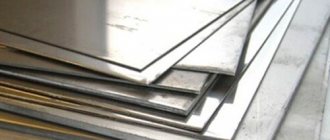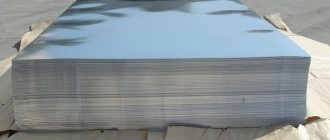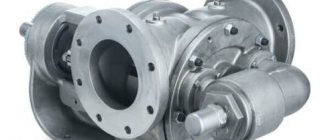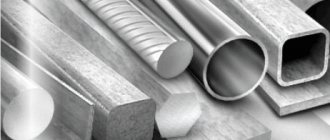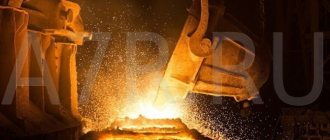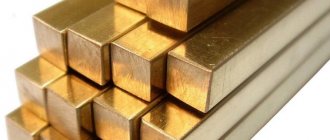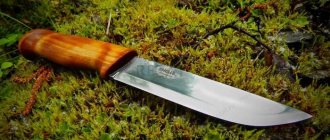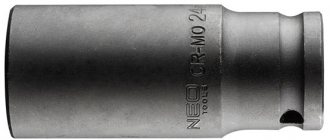You can place an order by phone
Our specialists will be happy to help you
+7
A comparison of AISI 430 and AISI 304 is required by many buyers to determine the optimal grade of steel for a specific purpose. According to the Russian classification, both of them should be classified as “heat-resistant, corrosion-resistant” and their chemical composition has certain similarities. However, there is a difference in cost and prevalence.
Scope of application
Practice shows priority products:
- AISI 304: furnace equipment, pipes for transporting solutions of acids and steam, heat exchangers and collectors, electrodes of automotive spark plugs, parts of welding and thermal power systems, chemical industry vessels. Permissible operating temperature is up to six hundred degrees. The chemical aggressiveness of the environment should be within average values; for maximum values, there are other solutions.
- AISI 430: fasteners and auxiliary parts for various devices and devices used in combination with moderate solutions of acids and salts. It can also often be found in everyday life: kitchen utensils and parts of kitchen and bathroom appliances.
Comparison of AISI 430 and AISI 304 allows you to choose the most suitable material. Some sources do not distinguish much difference between these materials, which is incorrect. Arbitrary replacement can have unpleasant consequences, expressed in design defects - up to fatal non-compliance.
Properties of alloys AISI 304 and 430 depending on the chemical composition
AISI 304 has excellent weldability and is easy to process (welding and forging). But the hardness index is less. Although this option is more expensive for use (due to the presence of nickel), AISI 304 is indispensable for the production of structures that have high requirements for manufacturability.
AISI 430 is subject to more complex types of welding and is not subject to hardening.
To understand how AISI 304 differs from AISI 430, you must also pay attention to their magnetic properties. Thus, AISI 304 belongs to non-magnetic alloys - austhenic class, and AISI 430 represents the ferrite class.
In addition to their basic qualities, alloys also differ in other properties.
- High strength and durability, the ability to manufacture parts and structures for use in aggressive environments.
- AISI 430 is more resistant to acidic and alkaline environments.
- Both metals are characterized by a low coefficient of thermal expansion.
- Externally, they differ in surface shades - AISI 304 is yellowish, and AISI 430 is white-blue.
Domestic analogues
Both brands are common and produced by various factories, both domestic and foreign. A wide range of applications allows them to be used for a variety of purposes. It’s easy for a non-specialist to get confused in the differentiating aspects, and first you need to decide on a theory.
It is more convenient to make comparisons using the corresponding GOST alloys, which are more familiar, reveal the chemical composition and are well described in the standards. AISI 430 approximately corresponds to 17X18 with its composition:
- 0.17% Carbon.
- 18% Chromium.
- Titanium is present in small quantities, but it is enough to have a qualitative effect on the properties. More precisely, AISI 430 allows comparison with both 17X18 and 17X18T.
AISI 304 is identical to 08Х18Н10:
- 0.08% Carbon.
- 18% Chromium.
- 10% Nickel.
Their silicon and magnesium content is approximately the same - they are rather auxiliary elements. Comparison of undesirable components gives comparable results: there should be a minimum of them. First of all, it is sulfur - which increases the risk of cracking during high heat. Often, the degree of purification of the alloy affects its cost - therefore, the cheapest version may not be the best.
Such differences in chemical composition give rise to the following differences in properties:
- AISI 304 has unlimited weldability, can be hardened and forged. At the same time, its hardness is lower, and the permissible heating is within six hundred degrees (with short exposure - up to eight hundred).
- AISI 430 is more difficult to weld and it is not recommended to strengthen it by heat treatment - this leads to cracks in unpredictable places. Among the advantages, it is worth noting the ability to withstand high temperatures and superior strength and hardness.
Accordingly, when higher technology is required, it makes sense to choose the first option. The second one stands for hardness and lower cost. In certain cases, both are allowed, and it’s worth choosing the more accessible and inexpensive one. Both brands are produced in various rolled products, which allows you to select the optimal blank for a specific product.
Stainless steel standards
There are state standards for different types of stainless steel in our country. They determine the quality of products made from this material. Stainless steel has different GOST standards. Certain quality standards are developed for thin sheets, for wire, for thick sheets and for stainless steel pipes.
Stainless steel has different characteristics. Thanks to its chemical and physical parameters, it easily resists the formation of corrosion plaque. This material was developed for use in places where there are different environmental conditions. Due to its heat resistance and strength, steel does not react with substances in the environment.
Series 200
Stainless steels, in which expensive nickel is partially replaced by manganese and nitrogen to stabilize the austenitic structure, have long established themselves as an effective substitute for standard chromium-nickel steels. These steels have proven themselves as a material for the manufacture of metal utensils, household kitchen utensils and apparatus.
In conclusion, we note: Steels of the 300 series are gradually losing ground to the more cost-effective austenitic steels of the 200 series and chromium steels of the 400 series. A change in priorities is clearly observed in the world.
Percentage of chemical compounds in combustion products
| SO3 (sulfur oxide) | CO2 (carbon dioxide) | W (humidity) | ||
| Wood | 0.5% | — | 90% | 6% |
| Natural gas | — | — | 90% | 10% |
| Diesel fuel | — | 3% | 90% | 10% |
| Coal | 1% | 3% | 90% | 6% |
Basic "Chimney" steels
AISI316 steel (including AISI316L and AISI316Ti ) is austenitic steel, today the best and optimal material for use in the production of smoke exhaust systems. It is suitable for use over a wide temperature range and is resistant to a large number of concentrated acids. This makes it universal in almost any heating system and for any type of fuel. This steel is indispensable in chimneys for condensing boilers and is the best option for smoke removal of diesel and gas appliances. AISI316 steel is high strength, corrosion resistant, ductile and heat resistant. The advantages of steel include the addition of molybdenum and a higher content of chromium and nickel. It does not corrode when exposed to aggressive condensate (mainly water vapor combined with sulfur contained in the fuel to form sulfuric acid) of flue gases, even at high temperatures. Withstands long-term heat load up to 600°C, and short-term up to 900°C. This allows us to provide a guarantee of up to 15 years on our chimneys. AISI 316 has no magnetic properties.
AISI310 steel is an austenitic steel, contains a high content of chromium and nickel, which gives the steel excellent oxidation resistance, belongs to the class of heat-resistant, heat-resistant steels. Such steels are capable of operating for quite a long time at temperatures up to 1000°C without changing the geometry, strength characteristics and appearance. It is most rational to use it in chimneys for heating devices operating on wood, coal, coke, etc. AISI310 is indispensable for smoke removal from high-temperature pyrolysis units, gas piston units, diesel generator units, etc. installations. AISI310 does not have magnetic properties.
AISI304 steel is an austenitic steel that has good acid-resistant properties when used in dry mode on low-temperature (up to 250°C) heating units and household boilers, copes well with weakly and moderately aggressive environments, and is actively used in the production of ventilation ducts in medical and children's institutions, in food and cosmetic industries. Operates reliably at high operating temperatures (up to 600°C) in dry mode in units with low-aggressive environments.
Indispensable in the production of guaranteed high-quality types of fasteners, mounting, load-bearing and decorative products. AISI304 does not have magnetic properties.
AISI321 steel is an austenitic steel grade containing chromium and nickel with the addition of titanium. It has excellent resistance to corrosion and high temperatures, but is not sufficiently resistant to sulfur-containing environments. It works well in long-term operation at temperatures in the range of 600-800°C, but in the welded state the steel should not be used in acidic, aggressive environments with high performance. AISI321 does not have magnetic properties.
AISI444 steel is a ferritic steel grade, due to alloying with molybdenum, stabilization with titanium and niobium and a fairly high (18%) chromium content, it has excellent anti-corrosion properties. Corrosion resistance for mildly aggressive environments is comparable to austenitic steels of the AISI316/316L class. These properties make it an ideal budget material for chimneys for low-temperature boilers, coaxial boilers for apartment heating, etc. A pronounced loss of strength occurs after 450°C. Heat resistance is lower than AISI430 and AISI439. AISI444 has magnetic properties.
AISI439 steel is a nickel-free ferritic steel, stabilized with titanium. Has high overall corrosion resistance. The overall corrosion resistance of steel in many environments is comparable to that of austenitic steels AISI321, AISI304. Steel is resistant to corrosion in air, oxidation at high temperatures, in solutions of many alkalis and in most organic acids. Additional advantages are that AISI439 steel is insensitive to corrosion intercrystalline destruction in the temperature range of 500-800°C. AISI439 has magnetic properties.
AISI430 steel is a ferritic steel and belongs to stainless heat-resistant steels for general use with rather low performance. They find application in areas with mildly corrosive environments or where heat resistance at moderate temperatures is required (
Why do you need food grade stainless steel?
The manufacture of various containers and utensils that come into contact with food products involves the selection of special materials that have special properties. Since even ordinary stainless steel, which is famous for its anti-corrosion properties, cannot always withstand aggressive chemical processes that are related to the food industry .
In these cases, the issue is resolved by using specialized food grade stainless steel compounds. It is these alloys that are best suited for the manufacture of various types of equipment for processing and storing food.
These compositions meet the highest requirements (toxicological, hygienic, aesthetic) for metals that can be used in the food industry.
Advantages of food grade stainless steel:
- environmentally friendly;
- easy to maintain;
- not afraid of most chemical environments;
- wear-resistant;
- complies with clear rules for the dissolution of heavy metals in working environments.
Stainless steel is rightfully one of the best materials for making cookware that is used in everyday life. No housewife will refuse a beautiful frying pan made of this steel, a saucepan, quite practical and elegant cutlery, and any other kitchen utensils. The surfaces of refrigerators, cookers, and so on are made from stainless steel. Today, the number of uses of stainless steel products in everyday life is constantly growing.
Manufacturers of various products and catering establishments install stainless pipes . They are also used for the manufacture of technological devices used at all stages of the food preparation process - for preparing and grinding raw materials, mixing, cooking, transporting, separating and sorting.
